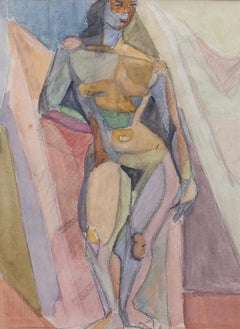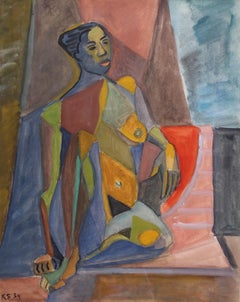Kosta Stojanovitch
Recent Sales
1950s Cubist Nude Drawings and Watercolors
Paper, Gouache
1950s Cubist Nude Paintings
Paper, Gouache
1950s Cubist Nude Drawings and Watercolors
Paper, Gouache
1950s Cubist Nude Drawings and Watercolors
Paper, Gouache
1950s Cubist Nude Drawings and Watercolors
Gouache
1950s Cubist Nude Paintings
Pastel, Gouache
1950s Cubist Nude Paintings
Paper, Gouache
A Close Look at Cubist Art
Inspired by the nontraditional ways Postimpressionists like Paul Cézanne and Georges Seurat depicted the world, Pablo Picasso and Georges Braque pioneered an even more abstract style in which reality was fragmented into flat, geometric forms. Cubism majorly influenced 20th-century Western art as it radically broke with the adherence to composition and linear perspectives that dated back to the Renaissance. Its watershed moments are considered Picasso’s 1907 Les Demoiselles d’Avignon, in which nude figures are fractured into angular shapes, and Georges Braque’s 1908 painting show, which prompted a critic to describe his visual reductions as “cubes.”
Although Cubism was a revolutionary art movement for European culture, it was informed by African masks and other tribal art. Its artists, which included Fernand Léger, Alexander Archipenko, Marcel Duchamp, Juan Gris and Jean Metzinger, experimented with compressing space and playing with the tension between solid and void forms in their work. While their subjects were often conventional, such as still lifes, nudes and landscapes, they were distorted without any illusion of realism.
Cubist art evolved through different distinct phases. In Analytic Cubism, from 1908 to 1912, figures or objects were “analyzed” into pieces that were reassembled in paintings and sculptures, as if presenting the same subject matter from many perspectives at once. The palette was usually monochromatic and muted, giving attention to the overlapping planes. Synthetic Cubism, dating from 1912 to 1914, moved to brighter colors and a further flattening of images. This unmooring from formal ideas of art would shape numerous styles that followed, from Dada to Surrealism.
Find a collection of authentic Cubist paintings, prints and multiples, sculptures and more art on 1stDibs.
Finding the Right Nude-drawings-watercolors for You
The human body has long been a favorite subject for artists throughout history. Nude drawings and watercolor paintings reveal the human figure but also the social ideals, traditions and cultural beliefs around people and bodies at the time they were created.
Nude drawings and watercolors offer a unique way to illustrate the human body. Drawings in pencil or ink can quickly capture movement or poses while watercolor is more expressive of a moment. Different cultures utilize the same materials differently, and each piece provides a singular glimpse into the perspectives and expectations around people’s bodies.
Artists like Francisco Goya, Gustav Klimt and Lucian Freud — who painted his friends, his lovers and his children — found acclaim and success by creatively depicting the human body. More recently, as contemporary artists have followed the figurative muse, many painters are exploring the nude as a subject for their drawings and works in watercolors.
If you’re thinking about bringing this kind of work into your space, there are many ways to consider how to arrange wall art in your living room or elsewhere in your home. Creating a wall of art is a wonderful way to enhance your space, showcase beautiful pieces and tie an interior design vision together. It allows you to evoke emotions in a room while also showing off your tastes and interests.
On 1stDibs, find a collection of nude drawings and watercolor paintings for diverse views and attitudes toward the human form through a range of cultures and times.

